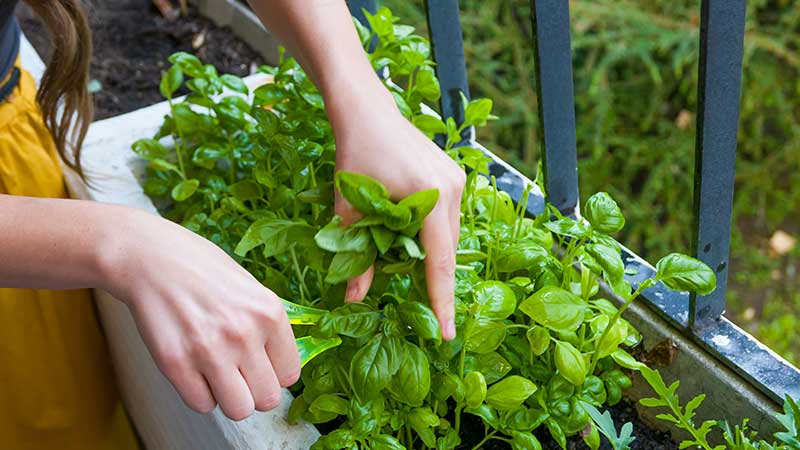

Basil is a fragrant, versatile, wildly popular herb. It’s a warm-weather plant that is easy to grow and delicious to eat. A nice addition to any number of culinary dishes, it is just about synonymous with summer time salads and pastas. It does well in both container and in-ground gardens. Basil smells wonderful and tastes even better.
Read on for everything you need to know about growing basil.
Despite its popularity in Italian and Mediterranean cuisine, basil is actually native to the South Pacific islands and southern Asia. It is a member of the mint family and grows as an annual. It is also quick-growing – from seed to harvest in just about 3 – 4 weeks – which makes this a rewarding herb to grow! If you haven’t grown herbs before, basil is a great one to start with.
There are multiple varieties of basil – each with its own unique characteristic and flavor.

Learning how to plant basil is simple as it is one of the easiest herbs to grow. Basil is not the least bit finicky, and with proper planting, care and harvesting, you can enjoy it all summer long!
One of the beauties of basil is there isn’t a real, definitive harvest time – just pick what you need as you need it. And the best part is the more you harvest, the more a basil plant will produce. Regular harvesting will keep plants full and round. Harvest before the plant goes to seed, or “bolts.” When basil goes to seed, the leaves will often have a bitter flavor.
Tip 1. Water consistently and regularly. Keep soil moist for optimal growth. Water early in the mornings for best results. If you are in a hotter region or having a heat wave, adding mulch around the plant can help keep moisture in.
Tip 2. Harvest often to encourage new growth.
Tip 3. If a basil plant starts to flower, the basil leaves will start losing flavor and the plant will stop growing. Removing the flowers will do the trick though, and that sweet basil flavor will return in a couple of days.
If properly cared for, basil can last for anywhere from 4 – 6 months. Typically, plants in posts will live closer to 4 months, whereas plants in the ground could live up to 6 months.
Basil is a warm-weather plant that thrives on full sun.
The most common cause of a drooping basil plant is not enough water. Basil loves evenly moist soil.
Basil flowers are edible and have a milder flavor than the leaves. Though sometimes a bit bitter, they can be used in salads, pastas or on anything else that basil complements. Another option is to infuse oil with the flowers or make basil flower vinegar for salad dressing. Basil flowers even make a great tea.
From the moment you pick it up, you’ll notice these nozzles are different. Designed with mobility in mind, they feature Gilmour’s innovative Swivel Connect. The swivel allows the nozzles to pivot without
Learn MoreWinter Gardening Tips to Tackle in the Off Season
As winter marches on, avid gardeners become more and more eager to get growing. While you may not be able to dig your spade into the soil just yet, there is plenty
Learn MoreDesign a Beautiful Drought Resistant Yard
Hot weather and drought-like conditions don’t mean a beautiful yard and garden is out of reach. Learn everything you need to know about drought tolerant landscaping, including the best type of plants,
Get the Dirt